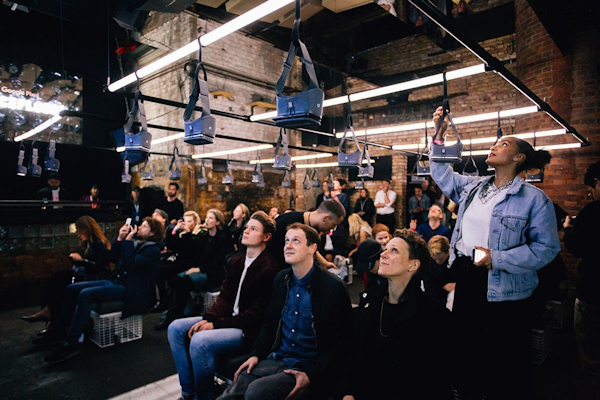[This story from Highsnobiety includes interesting comparisons of the real and virtual versions of clubbing (“the boundaries between URL and IRL [are getting] increasingly pixelated”); the original story includes two more images and a 1:15 interactive preview video (which viewed on YouTube leads to other full-length videos). –Matthew]

Is Virtual Reality the Future of Clubbing?
By Bianca Giulione
April 11, 2017
Since its creation in 2011, Boiler Room has become nearly synonymous with underground dance music. Often a rite of passage for musicians and enthusiasts alike, it has invariably changed the way dance music is consumed. Having been to my first IRL Boiler Room back in 2013 when it was still quite a novel concept, I recall the sheer joy of loading up on free drinks from whichever alcohol brand was the sponsor and getting extremely wavy with my friends, knowing homies who didn’t make the guest list would be watching and commenting away at our livestreamed debauchery in the chatroom (R.I.P., but good riddance, honestly).
Fast forward four years and I’m sitting in Berlin’s Arena Club strapping a Google Pixel powered Daydream VR headset to my head for Boiler Room’s first-ever VR experience. Up until this point, my brushes with virtual reality were limited to this weird virtual hang gliding game at my local arcade growing up, and a stomach-churning free fall from a plane on one of the first Oculus Rift headsets. Daydream is nothing of that sort. It’s not clunky and cold; it looks as if it’s cut from the same cloth as your favorite pair of sweatpants. If the singularity is nigh, that is, if artificial superintelligence is about to trigger changes to human civilization we can’t even imagine, at least it’ll be cute and cozy.
We’re told we have 10 minutes to explore the 15-minute virtual reality film, and that we’ll be tapped on the shoulder when our time is up. I press play and I’m immediately transported to a VR version of the same room we’re currently in. Techno trio FJAAK begins their set, configured in a triangle in front of racks of analog synths. I turn my head, surrounded by enthusiastic Berlin partygoers who seem familiar. They’re chatting, doing the Berlin techno 2-step, rolling cigarettes — party business as usual. Aside from the fact that the bodies are slightly translucent, they seem quite real.
With VR technology as it stands, you have a stationary but 360-degree point of view. If you attempt to walk forward, you won’t move in Daydream world, you’ll probably just bump into furniture. However, Boiler Room’s first VR experience is choose-your-own-adventure style — you can check out the chill out room, dance floor, be in the middle of FJAAK’s live setup, or if you’re lucky you just might find the dark room, where select shady things go down in many Berlin clubs.
Although I lived it virtually, the chill out room felt insanely “real” — a bunny suit-clad human was being gleefully spanked by partygoers, and someone was generating soothing drone sounds over excited chatter on a huge modular synthesizer, in contrast to the booming techno in the next room. Voyeurism is central to any live music experience; Boiler Room as a paradigm is no exception and even highlights this fact.
I remove my headset for a moment, looking around the room at the bodies completely absorbed in the VR experience. Before I put it back on and return to techno Daydream world, I think to myself that there’s no way I’ll need that tap on the shoulder to escape.
I am inclined to say that people often feel like the measure of a good live music experience is quantified by some sort of “authenticity.” Things like smartphones and selfie sticks distract from the “real.” But for a lack of a better term, let’s be real. Distinctions between IRL and URL are so 2015. Interacting with technology on a daily basis, if not constantly, is our reality. Sure my smartphone is rotting my brain or whatever, but technology hasn’t completely ruined our lives yet, by the looks of it. Tap. The nice Google employee gently assists me in snapping back to this dimension of existence we call reality.
After the VR demonstration, FJAAK added another layer to the meta-madness by performing live at the post-Daydream afterparty. It felt apt to compare the virtual Boiler Room experience I was just inside to this real party. Dancing is one of my favorite shared human activities, which is not quite the same when you’re wearing a headset. On the contrary, the cool thing about the film is that there were zero partygoers on their phones. This is usually not the case, even in some exclusive Berlin clubs where security staff cover your smartphone cameras with stickers.
But as Google and Boiler Room explained earlier in the evening, their version of VR as applied to clubbing-type experiences is not meant to be a replacement for it. Rather, it’s a way to make it accessible for people who might not be a part of the easyJet-set creative class. VR Dancefloors: Techno in Berlin is exactly that — a pretty darn accurate 15-minute representation of what it’s like to experience techno music in a typical Berlin club.
What’s next? House in Chicago? Grime in London? While the next installment of VR Dancefloors is yet to be revealed, rest assured it will quietly change the way you think about clubbing in a world where the boundaries between URL and IRL get increasingly pixelated.